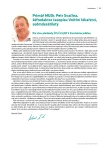Continuing peripheral nerve blocks – benefit for orthopedic patients with diabetes mellitus?
Authors:
David Doležal; Abdo Islam Saleh
Authors‘ workplace:
Klinika anesteziologie, resuscitace a intenzivní medicíny LF UK a FN Hradec Králové, přednosta MUDr. Tomáš Suchý
Published in:
Vnitř Lék 2015; 61(6): 559-562
Category:
Předneseno na mezioborovém sympoziu s postgraduálním zaměřením „Diabetik – společný pacient diabetologa a ortopeda“ 10. října 2014 v Hradci Králové.
Overview
There is increasing incidence of diabetes mellitus in population of developed countries. And there is also, together with this fact, an increasing frequency of surgical not only orthopedic procedures for diabetic complications or for other reasons. However, thanks to modern sophisticated perioperative approaches, diabetes itself is no longer main risk factor for worsening of perioperative morbidity and mortality. The organ complications of diabetes still remain the crucial for patients’ outcome. The individual approach to each patient is important when we are planning anesthesiological perioperative strategy. Assessment of long term diabetes compensation before elective surgical procedures, assessment and optimization of organ functions with searching for possible secondary complications of diabetes is also crucial. Generally, it is necessary to maintain compensation of diabetes through the whole perioperative period, avoid episodes of hypotension and tissue hypoperfusion and all anesthesiological interventions have to be targeted to rapid recovery (chronic medication, oral feeding and early rehabilitation). Technics of regional anesthesia and peripheral nerve blocks particularly, may be very useful for the objective especially for orthopedic patients.
Key words:
anesthesia – diabetes mellitus – perioperative period – peripheral nerve blocks
Sources
1. McAnulty GR, Robertshaw HJ, Hall GM. Anesthetic management of patients with diabetes mellitus. Br J Anaesth 2000; 85(1): 80–90.
2. Gu W, Pagel PS, Warltier DC et al. Modifying cardiovascular risks in diabetes mellitus. Anesthesiology 2003; 98(3): 774–779.
3. Margolis JR, Kannel WS, Feinleib M et al. Clinical features of unrecognized myocardial infarction silent and symptomatic. Eighteen year follow-up: Framingham study. Am J Cardiol 1973; 32(1): 1–7.
4. Vinik AI, Ziegler D. Diabetic cardiovascular autonomic neuropathy. Circulation 2007; 115(3): 387–397.
5. Wackers FJ, Young LH, Inzucchi SE et al. Detection of silent myocardial ischemia in asymptomatic diabetic subjects: the DIAD study. Diabetes Care 2004; 27(8): 1954–1961.
6. Kitamura A, Hoshino T, Kon T et al. Patients with diabetic neuropathy are at risk of a greater intraoperative reduction in core temperature. Anesthesiology 2000; 92(5): 1311–1318.
7. Porcellati F, Fanelli C, Bottini P et al. Mechanisms of arterial hypotension after therapeutic dose of subcutaneous insulin in diabetic autonomic neuropathy. Diabetes 1993; 42(7): 1055–1064.
8. Angelini G, Ketzler JT, Coursin DB. Perioperative care of diabetic patients. ASA Refresher Courses in Anesthesiology 2001; 29(1): 1–9.
9. Tang AT, El-Gamel A, Keevil B et al. The effect of “renal-dose” dopamine on renal tubular function following cardiac surgery: assessed by measuring retinol binding protein (RBP). Eur J Cardiothorac Surg 1999; 15(5): 717–721.
10. Erden V, Basaranoglu G, Delatioglu H et al. Relationship of difficult laryngoscopy to long-term non-insulin dependent diabetes and hand abnormality detected using the ‘‘prayer sign’’. Br J Anesth 2003; 91(1): 159–160.
11. Patel A, MacMahon S, Chalmers J et al. Advance Collaborative Group. Intensive blood glucose control and vascular outcomes in patients with type 2 diabetes. N Engl J Med 2008; 358(24): 2560–2572.
12. Kadoi Y. Anesthetic considerations in diabetic patients. Part I: preoperative considerations of patients with diabetes mellitus. J Anesth 2010; 24(5): 739–747.
Labels
Diabetology Endocrinology Internal medicineArticle was published in
Internal Medicine

2015 Issue 6
Most read in this issue
- Diagnosing and therapy of gout
- Alveolar echinococcosis – rare cystic disease of the liver – editorial
- Guidelines of Czech Association for Thrombosis and Haemostasis of the Czech Medical Association of J. E. Purkyně for safety treatment with new oral anticoagulants (NOAC) – dabigatran etexilate, apixaban and rivaroxaban
- “Stressful holiday” – takotsubo cardiomyopathy
